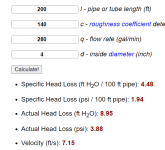I would tie in the filtration pump suction to the 4" Infinity Edge suction so that you can run the edge from the filtration pump if you want.
You can run both pumps at the same time to increase the flow over the edge to about 375 GPM, which would give you about 7/16" lift.
However, that puts the flow over 6 feet per second.
Below was my original suggestion of (3) 3" lines, which would have allowed for about 414 GPM at 6 feet per second.

You can run both pumps at the same time to increase the flow over the edge to about 375 GPM, which would give you about 7/16" lift.
However, that puts the flow over 6 feet per second.
Pipe Size and Flow Rates.
You want to keep the water velocity below 6 ft/sec on the suction and below 8 ft/sec on the pressure side of the pump.| Pipe Size | 6 ft/sec | 8 ft/sec |
|---|---|---|
| 1.5" | 38 GPM | 51 GPM |
| 2" | 63 GPM | 84 GPM |
| 2.5 | 90 GPM | 119 GPM |
| 3.0" | 138 GPM | 184 GPM |
| 4.0" | 235 GPM | 312 GPM |
Below was my original suggestion of (3) 3" lines, which would have allowed for about 414 GPM at 6 feet per second.

Blue = Main Drains.
Green = 2" or 2.5" PVC pipe.
Red = 3" PVC pipe.
Black dot = Check Valve.
Purple dot = Jandy NeverLube 2.5" (Inside) x 3" (Fitting Outside) two-way valve or 2" x 2.5" Jandy NeverLube two-way valves for skimmers and pool main drain.
There will be (2) 2.5" (Inside) x 3" (Fitting Outside) Jandy NeverLube Check valves after the Infinity Pump and (2) 3" Jandy NeverLube Check valves before the Filter Pump Suction Manifold.
This will allow you to adjust the edge flow and filter flow independently.











